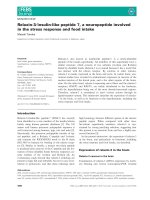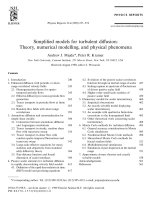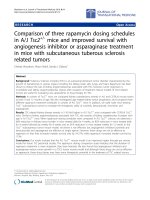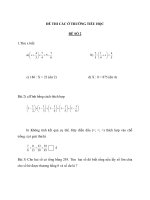(Advances in heterocyclic chemistry 7) a r katritzky and a j boulton (eds ) advances in heterocyclic chemistry elsevier, academic press (1967)
Bạn đang xem bản rút gọn của tài liệu. Xem và tải ngay bản đầy đủ của tài liệu tại đây (18.12 MB, 527 trang )
Advances in
Heterocychc
Chemistry
Volume 7
T
A. Albert
A. T. Balaban
G. Fodor
S. Gronowitz
J. Gut
R. Huisgen
N. K. Kochetkov
J. H. Ridd
Advances in
HETEROCYCLIC
CHEMISTRY
Edited by
A. R. KATRITZKY
A. J. BOULTON
School of Chemical Sciences
University of East Anglia
Norwich, England
Volume
Academic Press
.
New York and London
*
7
1966
COPYRIGHT@ 1966 ACADEMIC
PRESSINC.
ALL RIGHTS RESERVED.
NO PART OF THIS BOOK MAY B E REPRODUCED I N A N Y FORM,
B Y PHOTOSTAT, MICROFILM, OR A N Y OTHER MEANS, WITHOUT
WRITTEN PERMISSION FROM THE PUBLISHERS.
ACADEMIC PRESS INC.
111 Fifth Avenue, New York, New York IOOOS
United Kingdom Edition publiahed by
ACADEMIC PRESS INC. (LONDON) LTD.
Berkeley Square Houee, London W.1
LIBRARY
OF CONGRESSCATALOGCARDNUMBER:
62-13037
PRINTED I N THE UN I TED STATE8 OF AMERIOA
Contributors
Numbers in parentheses indicate the pages on which the authors’ contributions
begin.
P. BOSSHARD,
Institute of Organic Chemistry, University of Zurich,
Zurich, Switzerland (377)
E. DALTROZZO,
Physical-Chemical Institute, The Technical University,
Munich, West Germany (153)
JOHN J. EISCH,Department of Chemistry, The Catholic University of
America, Washington, D.C. ( 1 )
C. H. EUOSTER,
Institute of Organic Chemistry, University of Zurich,
Zurich, Switzerland (377)
EBERHARD
FUTTERER,
Chemisches Laboratorium der Universitiit
Freiburg, Freiburg-im-Breisgau, West Germany (39)
A. HETZHEIM,
Institut fii? Organische Chemie, Universitat Greifswald,
Grsifswald, German Democratic Republic ( 183)
A. R. KATRITZKY,
The School of Chemical Sciences, University of
East Anglia, Norwich, England (225)
K. MOCKEL,Institut f u r Anorganische und Physikalische Chemie der
Pddogogischen Hochschule Potsdam, Potsdam, German Democratic
Republic ( 183)
HORST
PRINZBACH,
Chemisches Laboratorium der Universitiit Freiburg,
Freiburg-im-Breisgau, West Germany (39)
G. SCHEIBE,
Physical-Chemical Institute, The Technical University,
Munich, West Germany (163)
G. SPITELLER,
Institute of Organic Chemistry, Vienna, Austria (301)*
S. M. WEEDS,The University Chemical Laboratory, Cambridge,
England (225)
* Present addre88 : Institute of Orgenic Chemistry, Gottingen, Germany.
V
This Page Intentionally Left Blank
Preface
The seventh volume of Advances in Heterocyclic Chemistry includes
surveys of four groups of heterocyclic compounds : furans (P.Bosshard
and C. H. Eugster), dithiolium salts (H. Prinzbach and E. Futterer),
1,3,4-oxadiazoles (A. Hetzheim and K. Mockel), and diquinolylmethanes (G. Scheibe and E. Daltrozzo). Further chapters deal with
applications of mass spectrometry to heterocycles (G. Spiteller), an
area which has expanded very rapidly of late, and the halogenation of
heterocycles (J.J. Eisch). Finally, a summary is given of reviews in
the heterocyclic field, classified by subject (A. R. Katritzky and S.
M. Weeds),which it is hoped may be of assistance in literature surveys.
Suggestions are welcomed for contributions to further volumes ;
they should be in the form of a short synopsis.
Thanks are due to the Editorial Board, the publishers, and the
authors for their cooperation.
A. R. KATRITZKY
A. J. BOULTON
Norwich, England
November, 1966
vii
This Page Intentionally Left Blank
Contents
CONTRIBUTORS.
PREFACE
.
.
.
.
.
.
.
.
.
.
CONTENTSOF PREVIOUS
VOLUMES
.
.
.
.
.
.
.
.
.
.
.
.
.
.
.
.
.
.
.
.
.
.
.
vii
.
.
.
.
.
.
.
.
.
.
.
.
.
1
9
24
.
.
.
V
xi
Halogenation of Heterocyclic Compounds
JOHN
J . EISCH
I. General Considerations
. . .
I1. Preparation of Halogen Derivatives .
I11. Mechanistic Aspects of Halogenation
.
.
.
.
.
The 1.2 and 1.3.Dithiolium Ions
HORSTPRINZBACH
and EBERHARD
FUTTERER
I. Introduction .
. .
I1. The 1.2.Dithiolium Ion
I11. The 1.3.Dithiolium Ion
.
.
.
.
.
.
.
.
.
.
.
.
.
.
.
.
.
.
.
.
.
.
.
.
39
41
103
.
.
.
.
.
.
.
.
.
.
.
.
.
.
.
.
. . .
. . .
. . .
. . .
153
154
157
170
175
Diquinolylmethane and Its Analogs
G . SCHEIBE
and E . DALTROZZO
I . Introduction .
. . . .
I1 Syntheses
. . . . .
111. Tautomerism of Quinolylmethanes
IV. Reactions a t C-9 . . . .
V . Reactions a t the Nitrogen Atoms
.
.
.
.
.
.
.
.
. . . . .
. . . . .
. . . . .
. . . . .
. . . . . .
.
.
.
.
Recent Advances in 1.3.4-Oxadiazole Chemistry
.
.
A. HETZHEIM
and K MOCKEL
I . Introduction .
. . . .
I1. Preparation of 1.3. 4.Oxadiazoles
.
I11. Reactivity of the 1.3.4.Oxadiazoles .
IV . Physical Properties of 1.3. 4.Oxadiazoles
V. Uses of 1.3. 4.Oxadiazoles
. .
ix
.
183
184
200
218
220
X
CONTENTS
The Literature of Heterocyclic Chemistry
A. R. KATRITZKY
and S. M. WEEDS
. .
. .
.
. . .
. . .
. . .
. . .
I. Introduction and General Discussion
11. Three-Membered Rings
.
111. Four-Membered Rings
. .
IV. Five-Membered Rings
V. Six-MemberedRings
VI. RingsofMoreThan SixMembers
VII. Heterocycles Containing Unusual Hetero Atoms
VIII. Special Topics
.
.
.
.
.
.
.
.
.
.
.
.
.
.
.
.
.
.
.
.
.
.
.
.
.
.
.
.
.
.
226
232
234
237
262
292
294
294
.
.
.
.
.
.
.
.
301
304
324
375
Mass Spectrometry of Heterocyclic Compounds
G. SPITELLER
I. Introduction .
. . . . . . .
11. Mass Spectra of Simple Heterocyclic Molecules
111. Special Groups of Heterocyclic Compounds .
IV. Mass Spectrometric Investigation of Mixtures
The Development of the Chemistry of Furans, 1952-1963
P. BOSSHARD
and C. H. EUQSTER
I. Introduction .
. . . . . .
11. Synthesesof theFuran Ring
. . .
111. Substitution Reactions of the Furan Ring
IV. Addition Reactions a t the Furan Ring
.
V. Elimination Reactions on the Furan Ring
VI. Ring Opening Reactions of Furans .
.
VII. Conversion of Furans into Other Systems
,
VIII. Alkoxy-, Hydroxy-, and Aminofurans
IX. SomeFuran Derivatives
. . . .
X. Naturally Occurring Furan Derivatives .
XI. Appendix
. .
. . . .
.
AUTHORINDEX
.
.
.
. .
.
.
.
.
.
.
.
.
.
.
.
.
.
378
379
396
413
436
436
449
460
470
472
489
.
491
Contents of Previous Volumes
Volume 1
Recent Advances in the Chemistry of Thiophenes
SALOGRONOWITZ
Reactions of Acetylenecarboxylic Acids and Their Esters with
Nitrogen-Containing Heterocyclic Compounds
R. M. ACHESON
Heterocyclic Pseudo Bases
DENESBEKE
Aza Analogs of Pyrimidine and Purine Bases of Nucleic Acids
J. GUT
Quinazolines
W. L. F. ARMAREGO
Prototropic Tautomerism of Heteroaromatic Compounds : I. General
Discussion and Methods of Study
and J. M. LAGOWSKI
A. R.KATRITZKY
Prototropic Tautomerism of Heteroaromatic Compounds : 11. SixMembered Rings
AND J. M. LAGOWSKI
A. R. KATRITZKY
Author Index-Subject Index
Volume 2
Prototropic Tautomerism of Heteroaromatic Compounds : 111.FiveMembered Rings and One Hetero Atom
AND J. M. LAGOWSKI
A. R. KATRITZKY
Prototropic Tautomerism of Heteroaromatic Compounds : IV. FiveMembered Rings with Two or More Hetero Atoms
AND J. M. LAGOWSKI
A. R. KATRITZKY
Three-Membered Rings with Two Hetero Atoms
ERNST
SCHMITZ
Free-Radical Substitutions of Heteroaromatic Compounds
AND G. K. RADDA
R. 0. C. NORMAN
The Action of Metal Catalysts on Pyridines
G. M. BADGER
AND W. H. F. SASSE
xi
xii
CONTENTS OF PREVIOUS VOLUMES
Recent Advances in Quinoxaline Chemistry
G. W. H. CHEESEMAN
The Reactions of Diazomethane with Heterocyclic Compounds
RUDOLF
GOMPPER
The Acid-Catalyzed Polymerization of Pyrroles and Indoles
G. F. SMITH
1,3-Oxazine Derivatives
Z. ECKSTEIN
AND T. URBA~~SKI
The Present State of Selenazole Chemistry
E. BULKA
Recent Developments in Isoxazole Chemistry
AND S. D. SOKOLOV
N. K. KOCHETKOV
Author Index-Subject Index
Volume 3
The Quaternization of Heterocyclic Compounds
G. F. DUFFIN
The Reactions of Heterocyclic Compounds with Carbenes
C. W. REESAND C. E. SMITHEN
The Carbolines
AND IAN
D. SPENSER
R. A. ABRAMOVITCH
Applications of the Hammett Equation to Heterocyclic Compounds
JONES
H. H. JAFFSAND H. LLOYD
1,2,3,4-Thiatriazoles
K. A. JENSEN
AND C. PEDERSEN
Nucleophilic Heteroaromatic Substitution
G. ILLUMINATI
Pentazoles
IVAR
U ~ I
Author Index-Sub j ect Index
Volume 4
Covalent Hydration in Nitrogen-Containing Heteroaromatic Compounds : I. Qualitative Aspects
AND W.L. F. ARMAREGO
ADRIENALBERT
CONTENTS OF PREVIOUS VOLUMES
xiii
Covalent Hydration in Nitrogen Heteroaromatic Compounds : 11.
Quantitative Aspects
D. D. PERRIN
Recent Advances in Oxazolone Chemistry
ROBERT
FILLER
Isothiazoles
R. SLACK
AND K. R. H. WOOLDRIDGE
Hetarynes
AND H. C. VAN DER P u s
H. J. DEN HERTOG
Reactivity of Azine, Benzoazine, and Azinoazine Derivatives with
Simple Nucleophiles
ROBERT
G. SHEPHERD
AND JAMES
L. FEDRICK
Author Index-Subject Index
Volume 5
Electronic Structure of Heterocyclic Sulfur Compounds
R. ZAHRADN~K
Theoretical Studies of Physico-chemical Properties and Reactivity
of Azines
R. ZAHRADN~K
AND J. KOUTECKP
1,2,4-Thiadiazoles
FREDERICK
KURZER
The Aminochromes
R. A. HEACOCK
Aromatic Quinolizines
B. S. THYAGARAJAN
Advances in Pyrrolizidine Chemistry
N. K. KOCHETKOV
AND A. M. LIKHOSHERSTOV
Author Index-Subject Index
Volume 6
Physicochemical Aspects of the Chemistry of Purines
J. H. LISTER
The Reduction of Nitrogen Heterocycles with Complex Metal
Hydrides
ROBERT
E. LYLEAND PAUL
S. ANDERSON
xiv
CONTENTS O F PREVIOUS VOLUMES
Heterocyclic Syntheses Involving Nitrilium Salts and Nitriles under
Acidic Conditions
FRANCIS
JOHNSON
AND R A M ~MADRO~~ERO
N
Cyclic Enamines and Imines
KARELBLAHAAND OTAKARCERVINKA
Substitution in the Pyridine Series : Effect of Substituents
R. A. ABRAMOVITCH
AND J. G . SAHA
Progress in Pyrazole Chemistry
A. N. KOSTAND I. I. GRANDBERG
Author Index-Subject Index
Halogenation of Heterocyclic Compounds
JOHN J. EISCH
Department of Chemistry, The Catholic University of America,
Waehington, D.C.
I. General Considerations . . . . . . . . . . . .
A. Significance of Halogenation in Heterocyclic Chemistry . .
B. Important Halogenating Agents . . . . . . . .
C. Current Research Emphasis and the Scope of This Review .
11. Preparation of Halogen Derivatives . . . . . . . .
A. Gross Transformations . . . . . . . . . . .
B. Addition Processes . . . . . . . . . . . .
C. Substitution Processes . . . . . . . . . . .
111. Mechanistic Aspects of Halogenation . . . . . . . .
A. Preliminary Classifications and Formalisms . . . . .
€3. Nature of the Reacting Species in the Reaction Medium.
.
C. Role of Experimental Conditions . . . . . . . .
D. Tentative Assessment of Transition State Models
. . .
E. Qualitative Localization Treatment of Heterocyclic Halogenation . . . . . . . . . . . . . . . .
F. Unsolved Problems and Vistas of Research . . . . .
1
1
3
8
9
9
10
16
24
24
26
28
30
32
36
I. General Considerations
A. SIGNIFICANCE
OF HALOGENATION
IN HETEROCYCLIC
CHEMISTRY
1. Synthetic Scope
The introduction of a halogen atom into the nucleus of an unsaturated heterocycle serves at once as a valuable synthetic route to heterocyclic derivatives and as a revealing probe of substitution processes
at unsaturated carbon. From a synthetic standpoint, aromatic and
heterocyclic halides have become more attractive starting materials
in recent years. Traditionally considered to be rather unreactive,
these vinylic halides had been found suitable only in certain reactions
1
For an excellent treatment of the preparative and mechanistic aspects of
aromatic halogenation, cf. P. B. D. de la Mare and J. H. Ridd, “Aromatic
Substitution : Nitration and Halogenation.” Butterworth, London and
Washington, D.C., 1959.
1
2
JOHN J. EISCH
[SEC.
1. A.2
such as : ( a )the formation of the Grignard or organolithium reagent;
( b ) displacement processes at elevated temperatures, usually conducted in the presence of copper salts; or ( c ) displacements occurring
under mild conditions when an electron-withdrawing substituent was
situated ortho or para (alpha or gamma in heterocycles)to the carbonhalogen bond. The introduction of superior reaction solvents for
organometallic processes (tetrahydrofuran and the glycol ethers)
and displacement reactions (dimethyl sulfoxide and dimethylformamide), as well as an appreciation of the role of benzyne and aryne
intermediates in aromatic substitution, promises a far greater
importance to these unsaturated halides.
2. Mechanistic Importance
A similar situation seems to obtain in our understanding of the
mechanisms of heterocyclic halogenation. Although copious research
has provided accurate insight into the electrophilic substitution
reactions of benzene derivatives, a correspondingly precise knowledge
of heterocyclic substitution still is lacking. Admittedly formidable
complexities, as the interplay of changing orientation with experimental conditions, the significance of n- or r-species in the preequilibria to reaction, the uncertain role of intermediate covalent
addition compounds, and the possibility of rearrangements, remain
unresolved. To this already bristling thicket of difficulties may be
added the greater number of substitution isomers possible with many
heterocyclic systems. It would appear, however, that this latter
point may be viewed as an advantage for the researcher hoping to
test his grasp of substitution processes at unsaturated carbon. This
gradation of electronic environment within the same heterocyclic
system permits the distribution of substitution isomers to be viewed
as the result of a competition experiment. Hence the many complications mentioned previously can be largely canceled. More recent
examination of heterocyclic substitution has demonstrated two
valuable points in this connection : first, that the severe conditions of
nitration, halogenation, and other substitutions traditionally used
with many heterocycles are not necessary for successful reaction; and
second, that the orientation displayed by heterocycles is highly
dependent upon the polarity of the reagent and the medium.
Counterpoised to these experimental difficulties are certain distinct
advantages to studies of heterocyclic halogenation. In the first place,
the halogen family comprises a rationally related series of electrophilic
SEC.
I. B. 13 HALOGENATION OF HETEROCYCLIC COMPOUNDS
3
reagents of gradated reactivity and selectivity,running the gamut from
the rather inert molecular iodine to the violently reactive fluorine.2
A second advantage to halogenation as a mechanistic probe is the
wide range of solvent polarity and acidity which can be feasibly
employed. Pyridinoid heterocycles, for example, can be studied either
aa the protonated amine (in concentrated sulfuric acid) or as the free
base (in carbon tetrachloride) with marked consequences on the rate
and orientation of substitution. Third, the resulting orientation and
reactivity data obtained from such adaptable halogenation studies
can serve as an index of electronic character at different reacting sites
in unsaturated heterocycles.
B. IMPORTANT
HALOQENATINGAQENTS
1. Neutral Reagents
Among the customary halogenating agents, the most widely
acceptable are molecular chlorine and bromine. Unfortunately, no
widely applicable and easily regulated method for limited substitution
by elemental fluorine is available.2 I n contrast, the unaided attack of
molecular iodine is too slow in many cases. I n the latter instance both
kinetic and thermodynamic factors (reversal by the hydrogen iodide
by-product) conspire against a fruitful iodination. Table 1 lists certain
properties of particular interest for some halogen and interhalogen
molecules. The relatively weak bonds in molecular fluorine and iodine
predispose these halogens to homolytic processes. I n addition, the
oxidizing action of the elemental halogen also comes to the fore with
these same members :with fluorine, because ofits high oxidizingpower;
with iodine, because its lower halogenating action permits the competing oxidation to become prominent. Finally, the relative acidities
of the halogens, as exhibited toward the chloride ion, give some indication of their tendency to form n-or n-adducts with heterocyclic bases.
Although nonsolvating media of low polarity are sometimes suitable
for reactive heterocycles, more often polar or basic solvents such as
2
Although controlled substitution with molecular fluorine is difficult to
attain, noteworthy is the recent success in perfluorinating both saturated
and unsaturated heterocycles by electrolysis in anhydroushydrogen fluoride.
Cf. T. C. Simmons and F. W. Hoffmann,J . Am. Chem. SOC.79, 3429 (1967),
for the preparation of undecafluoropiperidine (from piperidine). The latter
compound can be converted into pentafluoropyridine by passing it over an
iron contact at 600' [R. E. Banks, A. E. Ginsberg, and R. N. Haszeldine,
J . Chem. SOC.p. 1740 (19Sl)l.
4
[SEC.I. B.2
JOHN J. EISCH
TABLE I
PROPERTIES
OF CERTAIN HALOQEN
MOLECULES
Property
Molecular weight
38.0
Boiling point C)
- 187
Bond energy (kcal/mole)
38
Bond length (A)
1.44
Electronegativity of X
3.90
Electron affinity of X
(kcal/gm-atom)
83.5
Acid strength toward aqueous
c1- ( - AF")"
Oxidation potential of X* (H2O) - 2.85
(O
a
70.9
160
59
46
58
2.28
1.98
2.95
3.16
- 35
87
4.4
1.36
82
0.04
1.09
254
184
36
2.66
2.65
162
97
50
75
- 1.14
0.54
- 5.7
-
R.L. Scott, J . Am. Chem. SOC.75, 1550 (1953).
ethyl ether, 1,4-dioxane, ethanol, acetic anhydride, glacial acetic
acid, chloroform, and water are desirable. For media of low polarity
small added amounts of ethers and amines appear to catalyze the
1 : 1 halogen adducts of ethers (dioxhalogenation p r o c e ~ s .That
~
ane .Br,) and of amines (pyridine -1,) have been characterized tends
to implicate halogen complexes as the catalytically significant species
in these cases.4
2. Sources of Positive Halogen
To catalyze the attack on certain heterocycles, the halogen may be
supplemented by a Lewis acid. Granted that the mechanistic details
of these so-called "positive " halogenations are supported only by
circumstantial evidence, the generation of a complexed X+ or the
radical X seems to be involved. Aluminum and ferric halides, silver
salts, and possibly solutions of halogen in concentrated or fuming
sulfuric acid appear to be cases in point. Other potential sources of
"positive" halogen are the interhalogen compounds (BrCl, BrI, ICl)
and CF3C02X,tert-C4H,0C1, SOC12,and S02Clz,but little is known
about their detailed behavior. Recent studies on the halogenation of
-
Pajeau, Bull. SOC.Chim. France p. 621 (1961); cf. A. P. Terent'ev, L. I.
Belen'kii, and L. A. Yanovskaya, Z h . Obehch. K h i m . 24, 1265 (1954); see
Chem. Abatr. 49,12327 (1955) for brominations effected by dioxane dibromide.
4 0. Hassel, Danak Tidaakr. Farm. 36, 41 (1962); see Chem. Abetr. 57, 9228
3 R.
(1963).
SEC.I. B.21 HALOGENATION
OF HETEROCYCLIC COMPOUNDS
5
methyl pyrrole-2-carboxylate suggest that the selective chlorination
at C-5 with tert-butyl hypochlorite is due to a radical process. The
indiscriminate attack a t C-4 and C-5 by molecular chlorine and by
sulfuryl chloride in the presence of peroxides indicates the importance
of both polar and radical processes.4aOn the other hand, halogenations
TABLE I1
HETEROCYCLIC
HALOGENATION
PROCEDURES
Neutral
XZ(Clz, Brz, Iz, I c l ) in CHC13, cc14, CSz, CaH6, ROR, or R O H
with HX scavenger: MCO3, HgO, RzSO, MOAc
0
/I
X-N(C-R),Hz-.
in CC14
SOXz, SOzXz, PC15, tert-C~HsOCl
Acidic
Xz (Clz, Brz, 1 2 ) in HOH, ROH, RCOOH, (RC0)zO
Xz in conc. HzS04 or HzS207
with or without AgzSO4
Xz with AlzXs, AgOAc
Xz with acidic oxidant: HX03, H N 0 3
0
ll
X-N(C-R),HZ-n
with AlzX6, Fez&
HX with oxidizing conditions: H ~ 0 2RzSO,
,
anodic electrylosis
H O X or Pc15
Basic
Xz (Clz, Brz, 1 2 ) in aqueous solution with RsN, NaOH, NaOAc, NazC03
Xz added to preformed metallic salt, M-R, prepared from R-H f MR’, MH,
MOH, or MOR
by solutions of hypohalous acids have been shown by kinetic studies
to involve “positive” halogen species (X+ in its solvated forms,
X-OH2+, X-OHR+, or X-NR,+). By and large, then, similar
4*
P. Hodge and R. W. Rickards, J. Chem. SOC.p. 459 (1965).
6
JOHN J. EISCH
[SEC.I. B.3
moieties seem important in the halogenating action of N-haloamides
(N-bromosuccinimide)and acyl hypohalites (CHSCOzX)in aqueous
solution.
Less explored halogenation methods of promise involve the use of
N-haloamides in nonaqueous media and the combination of an alkyl
or hydrogen halide with an oxidizing agent. Despite their wide
acceptance as reagents for allylic bromination, the N-haloamides
(N-bromosuccinimide, N-haloacetamides, and N-halohydantoins)
have not been utilized to their full in aromatic nuclear substitution.6
The controlled halogenation by the use of sulfoxides or peroxides with
hydrogen halidese or alkyl halides' generates the actual halogenating
agent in situ (solvated X+ or Xz). This permits the substitution of
sensitive, reactive nuclei under mild conditions without a large excess
of reagent. I n Table I1 are compiled some of the most important
halogenating agents for heterocyclic systems and their appropriate
experimental conditions.
3. Individuating Character of the Heterocycle
In closing this brief survey of halogenating agents, comment is in
place on the role which the specific heterocycle plays in the choice of
halogenating agent. The hydrogen halide liberated in the halogenation
may interfere in two ways. Either it may protonate some of the unreacted heterocycle, thereby depressing or changing the nuclear
reactivity, or it may cause reversal of the halogenation process. Consequently, the inclusion of hydrogen halide scavengersis desirable ; these
may be bases (NaHCOS,NaCzHSO2,
CaCO,, or R3N)or oxidizingagents
(HNOs, HXOS,or SO,). Occasionally, the change in the heterocycle's
orientation upon protonation may be turned to preparative advantage.
Witness the following reactions in which substitution occurs exclusively in the pyridinoid8 or benzenoid@ring, depending upon the
acidity of the medium [Eqs. (1) and (2)] :
See, e.g., Ng. Ph. Buu-Hoi and J. Lecocq, Compt. Rend. 222, 1441 (1946);
226, 87 (1948); H. Schmid, Helv. Chim. Acta 29, 573 (1946).
6 H. Gilman and J. Eisch, J . Am. Chem. SOC.
77, 3862 (1955).
7 B. C. Saunders and B. P. Stark, Tetrahedron 4, 169 (1958); T. L. Patterson
and H. 1,. Pan, J . Am. Chem. Soc. 78, 4812 (1956); Chem. Ind. (London)
p. 660 (1957).
8 J. J. Eisch, Chem. Ind. (London)p. 1449 (1959); J . Org. Chem. 27, 1318
(1962).
9 P. B. D. de la Mare, M. Kiamud-din, and J. H. Ridd, Chem. I d . (London)
p. 361 (1958); J . Chem. SOC.p. 561 (1960).
6
SEC.
I. B.31 HALOGENATION OF
HETEROCYCLIC COMPOUNDS
7
With heterocycles possessing fairly acidic hydrogens (e.g., pyrroles,
indoles, and imidazoles),highly basic conditions may lead to halogenation via the conjugate base of the heterocycle. An appealing modification for preparative halogenation then would seem t o be the
TABLE I11
THEVARIEUATED BROMINATION
OF QUINOLINE
Product (yield, %)
1-Dibromide (ca 100)
2-Bromo (5&60)
3-Bromo (91)
4-Bromod
5-Bromo (28)
6-Bromo (ca 2 ) p
8-Bromo (29)
3.6-Dibromo (35)
6,8-Dibromo (43)
3,6,8-Tribromo
5,6,8-Tribromo
Conditions
Brz in cold CClp
Brz in vapor phase at 500°*
Brz in hot cc14 with C5H5Nc
3-Bromoquinoline . HBr at 300°C
Brz and AgzS04 in HzS04f
Brz in hot CC14 with CgH5Nf
Brz and AgzSO4 in HzSO4f
Brz in glacial HOAcc
2Brz and AgzSO4 in HzSO4f
Brz in glacial HOAcc
3Brz and Ag~S04in HzSO4f
J . J. Eisch, Chem. Znd. (London)p. 1449 (1959).
H. E. Jansen and J. P. Wibaut, Rec. Trav. Chim. 56, 699 (1937).
c J. J. Eisch,J. Org. Chem. 27, 1318 (1962).
d A 38% yield of quinoline was realized.
6 J. J. Eisch, J . Org. Chem. 27, 4682 (1962).
f P. B. D. de la Mare, M. Kiamud-din, and J. H. Ridd, J . Chem. SOC.
p. 561 (1960).
0 Presumed precursor of 3,6-dibromoquinoline.
a
b
JOHN J. EISCH
8
[SEC.
I. c.
irreversible generation of the conjugate base and the addition of a
halogen source10 [Eq. (3), cf. Section II,C, 11:
I-
0-J
I
H
CaHsMgBr
0-j
r-c=c-I
~
~JJ'
(3)
H
MgBr
To stress the variation in site of substitution possible with a given
heterocycle consider the response of quinoline under the different
conditions shown in Table 111. The results also exemplify other
intriguing aspects of halogenation, such as reversibility, temperature
coefficient, and metal salt catalysis. These will be discussed in Sections
11,C, 3 and 111,C.
C. CURRENT
RESEARCH
EMPHASIS
AND
THE
SCOPEOF THIS REVIEW
Appreciable recent effort has been devoted to developing highly
selective methods for halogenating heterocycles. The method of
Derbyshire and Waters (halogen, silver sulfate, and concentrated
sulfuric acid) has been applied to quinolineQgiving results in agreement with nitration. Quite similar orientation patterns in halogenation
have been obtained with quinoline and isoquinoline by use of stoichiometric amounts of aluminum chloride. The reductive halogenation
of sulfoxides with hydrohalic acids has special appeal for the substitution of cyclic sulfides.6 The vapor phase halogenation of heterocycles under improved contact catalysis appears to be an attractive
approach to desired isomers, if decomposition and rearrangements are
minimized.
The complexity of individual halogenation mechanisms has become
clear in more recent years from the diverse isomer distributions
observed under different reaction conditions. Quantitative product
studies are beginning to make a welcome appearance, but kinetic
studies are almost wholly lacking. The recent kinetic work on the
iodination of imidazole may signal the onset of improvement in this
aspect. On the theoretical side, much attention has been given to the
several possible quantum mechanical approximations applicable to
heterocyclic substitution. Here again the lack of ample quantitative
10 V.
Franzen, Ber. 87, 1148 (1954).
D. H. Derbyshire and W. A. Waters, J . Chem. SOC.
pp. 564 and 674 (1950).
12 M. Gordon and D. E. Pearson, J . Ovg. Chem. 29, 329 (1904).
11
SEC.11. A.] HALOGENATION
OF HETEROCYCLIC COMPOUNDS
9
data seems not to give these theoretical views enough rope with which
to hang or to save themselves.
I n this survey the emphasis will be placed upon the newer findings
in the synthetic and mechanistic aspects of heterocyclic halogenation.
As to mechanisms, it appears both necessary and desirable to outline
possible views among which present knowledge cannot decide.
Hopefully the enthusiasm and curiosity of chemists will be awakened
when they appreciate the many unresolved problems in heterocyclic
halogenation.
11. Preparation of Halogen Derivatives
A. GROSSTRANSFORMATIONS
The classical ambiguity between direct substitution on an aromatic
system and substitution via an addition-elimination pathway [Eq.
( IS), Section 111,A] persists for the halogenation of heterocycles under
conditions of low polarity. Indeed, with suitable heterocyclic nuclei
the three possibilities of substitution, addition, and addition-elimination have all been observed. From existing evidence one cannot assign
as yet relative importance to these limiting cases in halogenation
mechanisms. However, experimental conditions often can be regulated
to favor one or other process for preparative success. These three
processes will receive our attention in this review.
Of lesser relevance to this discussion are halogenation methods
involving the modification of the carbon skeleton (synthesis and
degradation). The Hunsdiecker reaction, as applied to certain
heterocyclic acids, has had limited application for the synthesis of
halogen derivatives. The preparation of 3-bromo-4,6-dimethyl-2pyridone from the silver salt of the respective 3-carboxylic acid by
treatment with bromine in carbon tetrachloride is a rare example of
success. l 3 The interaction of carbenes with heterocycles also has been
employed infrequently, but recent advances in carbene generation
may reactivate this approach. l 4 The Ciamician-Dennstedt ring
expansion of pyrrole to p-halopyridines is a case in point15 [Eq. (4)]:
CJ - DC’
CHCls/?iaOH
H
R. G. Johnson and R. K. Ingham, Chem. Rev. 56, 247 (1956).
14 J. Hine, “Divalent Carbon.” Ronald Press, New York, 1964.
15 Cf. C. L. Closs and G. M. Schwartz,J. Org. Chem. 26,2609 (1961).
13
(4)
10
JOHN J. EISCH
[SEC.
11. B.l
These and other methods of introducing halogen into heterocycles,
such as the transformation of a- and y-hydroxypyridinoid bases with
inorganic acid halides, the treatment of pyridinoid N-oxides with
sulfur or phosphorus halides, and the decomposition of diazonium
compounds, are treated adequately in existing references.
B. ADDITIONPROCESSES
1, Types of Adduction
A posteriori, the addition of halogen to heterocycles can ensue in
at least three distinct fashions, exemplified by the following adduct
types: (a)covalent bonding of halogen to carbon with the partial or
complete saturation of the ring16 (1); ( b ) n-complexation of the
halogen at the hetero atom4*17(2); and ( e ) .rr-complexation of the
molecular halogenla (3). Whereas n and n types of adduction occur
with extreme eaae, the covalent fixation of halogen may require
photochemical or radical source promotion. Molecular chlorine
dissolved in carbon tetrachloride, in conjunction with illumination and
iodine promoter, constitutes a successful set of conditions for many
More polar solvents and elevated temperatures often
cases.l9,
cause the decomposition of intermediate adducts, either by hydrogen
halide elimination20[Eq. ( 5 ) ]or by solvolytic substitution21[Eq. (S)] :
lgspb
16 R.
17
Stoermer and €3. Kahlert, Ber. 35, 1633 (1902).
J. J. Eisch and B. Jaselskis, J. Org. Chem. 28,
2865 (1963).
P. Lang, J . Am. Chem. SOC.84,4439 (1962).
19 See, e.g., S. Maffei, S. Pietra, and A. Cattaneo, Buzz. Chim. Jtal. 83, 812
18 R.
(1953).
19aA. Cattaneo, F a m c o (Pawia),Ed. Sci. 12, 930 (1957); see Chem. Abstr.
52, 11850 (1958).
19b C . Bodea and M. Raileanu, Ann. 631, 194 (1960).
zoH. L. Coonradt and H. D. Hartough, J . Am. Chem. SOC.70, 1168 (1948);
R. Pieck and J. C. Jungers, Bull. SOC.Chim. Belgee 60, 357 (1951).
21 N.Clauson-Kacts, S.-0. Li, and N. Elming, Actu Chem. Scand. 4,1233 (1950).









